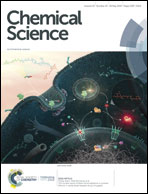Nitrogen-coordinated cobalt nanocrystals for oxidative dehydrogenation and hydrogenation of N-heterocycles†
Abstract
To endow non-noble metals with the high catalytic activity that is typically exhibited by noble metals is the central yet challenging aim for substituting noble metals. In this regard, by exploiting the coordination effect of nitrogen, we prepared cobalt nanocrystals stabilized by nitrogen-doped graphitized carbon (Co NCs/N-C). The obtained Co NC/N-C catalyst showed extraordinary performances toward both oxidative dehydrogenation of N-heterocycles and its reverse hydrogenation process under extremely mild conditions. A nearly quantitative conversion could be achieved for oxidative dehydrogenation even at room temperature (25 °C), for which the coordination effect of nitrogen is responsible: the interaction of Co–N induces a partial positive charge on the Co surface, thereby promoting the reaction. In contrast, cobalt nanocrystals supported by pristine carbon (Co NCs/C) proved to be inactive for oxidative dehydrogenation, owing to the lack of nitrogen. Moreover, in Co NCs/N-C, the N-doped graphitized carbon formed a protective layer for Co NCs, which preserved the active valence of Co species and prevented the catalyst from leaching. It was found that the catalyst still retained its excellent catalytic activity after five regeneration cycles; in comparison, its cobaltous oxide counterpart (CoOx/N-C) was barely active. As for the mechanism, electron paramagnetic resonance (EPR) analysis revealed the formation of superoxide anion radicals during the dehydrogenation process. Interestingly, the pressure of feed hydrogen had little effect on the hydrogenation process. Our Co NC/N-C catalyst is capable of activating molecular oxygen and hydrogen as effectively as noble metals; the coordination effect of nitrogen and the protection by the carbon layer in combination confer tremendous potential on the Co NCs/N-C for substituting noble-metal-based catalysts and soluble catalysts for homogeneous reactions.



 Please wait while we load your content...
Please wait while we load your content...